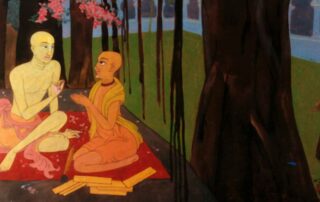Śrīman Mahāprabhura Śikṣā Chapter 6
Śrīman Mahāprabhura Śikṣā ('The teachings of Śrīman Mahāprabhu') was written by Bhaktivinoda Ṭhākura in 1892. This work of eleven chapters deals with the ten principle philosophical points expounded by Śrī Caitanya (known as the daśa-mūla) principally citing the Caitanya-caritāmṛta as evidence.
Śrīman Mahāprabhura Śikṣā Chapter 5
Śrīman Mahāprabhura Śikṣā ('The teachings of Śrīman Mahāprabhu') was written by Bhaktivinoda Ṭhākura in 1892. This work of eleven chapters deals with the ten principle philosophical points expounded by Śrī Caitanya (known as the daśa-mūla) principally citing the Caitanya-caritāmṛta as evidence.
Śrīman Mahāprabhura Śikṣā Chapter 4
Śrīman Mahāprabhura Śikṣā ('The teachings of Śrīman Mahāprabhu') was written by Bhaktivinoda Ṭhākura in 1892. This work of eleven chapters deals with the ten principle philosophical points expounded by Śrī Caitanya (known as the daśa-mūla) principally citing the Caitanya-caritāmṛta as evidence.
Hari-nāma Cintāmaṇi – Chapter 15
Śrī Hari-nāma Cintāmaṇi was written in 1900 by Śrīla Bhaktivinoda Ṭhākura. This work of fifteen chapters composed in Bengali verse form, explains in detail the process of chanting the Holy Name, and especially deals with the ten offences as delineated in the Padma Purāṇa. The narrative is a dialogue between Śri Caitanya Mahāprabhu and Śrīla Hari Dāsa Ṭhākura. In the introduction, Bhaktivinoda Ṭhākura states that Hari-nāma Cintāmaṇi is based upon rare texts that he discovered during his research.
Śrīman Mahāprabhura Śikṣā Chapter 3
Sriman Mahaprabhura Siksa ('The teachings of Śrīman Mahāprabhu') was written by Bhaktivinoda Ṭhākura in 1892. This work of eleven chapters deals with the ten principle philosophical points expounded by Śrī Caitanya (known as the daśa-mūla) principally citing the Caitanya-caritāmṛta as evidence.
Hari-nāma Cintāmaṇi – Chapter 14
Śrī Hari-nāma Cintāmaṇi was written in 1900 by Śrīla Bhaktivinoda Ṭhākura. This work of fifteen chapters composed in Bengali verse form, explains in detail the process of chanting the Holy Name, and especially deals with the ten offences as delineated in the Padma Purāṇa. The narrative is a dialogue between Śri Caitanya Mahāprabhu and Śrīla Hari Dāsa Ṭhākura. In the introduction, Bhaktivinoda Ṭhākura states that Hari-nāma Cintāmaṇi is based upon rare texts that he discovered during his research.
Śrīman Mahāprabhura Śikṣā Chapter 2
Śrīman Mahāprabhura Śikṣā ('The teachings of Śrīman Mahāprabhu') was written by Bhaktivinoda Ṭhākura in 1892. This work of eleven chapters deals with the ten principle philosophical points expounded by Śrī Caitanya (known as the daśa-mūla) principally citing the Caitanya-caritāmṛta as evidence.
Hari-nāma Cintāmaṇi – Chapter 13
Śrī Hari-nāma Cintāmaṇi was written in 1900 by Śrīla Bhaktivinoda Ṭhākura. This work of fifteen chapters composed in Bengali verse form, explains in detail the process of chanting the Holy Name, and especially deals with the ten offences as delineated in the Padma Purāṇa. The narrative is a dialogue between Śri Caitanya Mahāprabhu and Śrīla Hari Dāsa Ṭhākura. In the introduction, Bhaktivinoda Ṭhākura states that Hari-nāma Cintāmaṇi is based upon rare texts that he discovered during his research.
Śrīman Mahāprabhura Śikṣā Chapter 1
Śrīman Mahāprabhura Śikṣā ('The teachings of Śrīman Mahāprabhu') was written by Bhaktivinoda Ṭhākura in 1892. This work of eleven chapters deals with the ten principle philosophical points expounded by Śrī Caitanya (known as the daśa-mūla) principally citing the Caitanya-caritāmṛta as evidence.
Hari-nāma Cintāmaṇi – Chapter 12
Śrī Hari-nāma Cintāmaṇi was written in 1900 by Śrīla Bhaktivinoda Ṭhākura. This work of fifteen chapters composed in Bengali verse form, explains in detail the process of chanting the Holy Name, and especially deals with the ten offences as delineated in the Padma Purāṇa. The narrative is a dialogue between Śri Caitanya Mahāprabhu and Śrīla Hari Dāsa Ṭhākura. In the introduction, Bhaktivinoda Ṭhākura states that Hari-nāma Cintāmaṇi is based upon rare texts that he discovered during his research.










